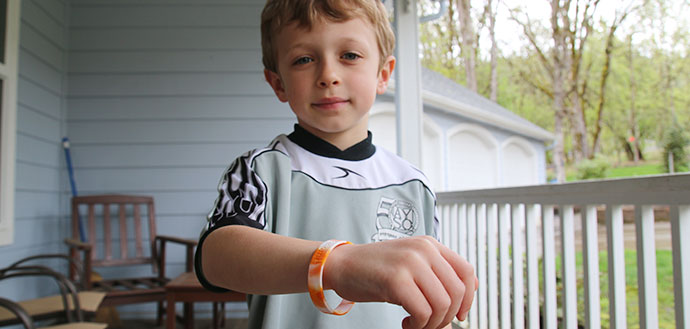
For the first time, researchers found that lightweight, silicone wristbands can be used as personal monitors to detect flame retardant exposure in young children.
The study, from NIEHS-funded Environmental Health Science Center at Oregon State University, included College of Public Health and Human Sciences researchers Molly Kile, Megan McClelland, Megan MacDonald and Shannon Lipscomb, as well as Kim Anderson in the College of Agricultural Science.
“Flame retardant chemicals are commonly added to many products we have in our built environment such as sofas, car seats, electronic equipment and household insulation in order to meet specific flammability standards,” Molly says. “As the foam breaks down, these chemicals are released into the air and accumulate in air and dust. There is some evidence that links flame retardant exposure to poor brain and reproductive organ development and endocrine and immune system dysfunction in animal studies.”
“One class of flame retardants, polybrominated diphenyl ethers (PBDEs), were phased out of production in the U.S. in the mid-2000s because of their harmful effects on health. Organophosphate flame retardants (OPFRs) are now being used in products as a replacement chemical for PDBEs. Although less is known about how OPFR exposure affects health, emerging evidence suggests exposure to these chemicals adversely affects neurodevelopment.”
Researchers recruited preschoolers to wear the wristbands continuously for seven days. The wristbands detected 20 flame retardant chemicals, 11 of which were found in more than 60 percent of the samples. PBDEs were detected at a high frequency, even though these chemicals no longer are being produced in the United States. OPFRs were detected at a higher frequency and concentration than PBDEs, suggesting that children are being exposed to replacement chemicals not subject to regulatory policies.
“We saw that kids living in homes built before 2005 tended to have higher levels of PDBEs, but children living in newer homes had higher OPFRs,” Molly says. “These results illustrate how chemical regulatory policy can influence children’s exposure to these compounds and the shift away from PBDEs to other flame retardant chemicals in the United States.”
The OSU study was broadly interdisciplinary and included child development researchers who are currently investigating links between children’s exposure to flame retardants and their socio-demographics circumstances and social behaviors.
“We found that children who lived in newer homes built after 2005 had more exposure to organophosphate-based flame retardants that replaced the polybrominated flame retardants,” said Shannon, an expert in child development and early education. “Children who live in homes build before 2005 had somewhat higher exposure to brominated flame retardants.”
In addition to the age of housing, frequency of vacuuming and sociodemographic factors lead to some children being exposed to higher levels of these chemicals than others. For example, PBDE and OPFR levels were higher in the wristbands of kids from homes where vacuuming occurred frequently.
“This may be because the heat and physical agitation generated while vacuuming could free the chemicals from household dust, releasing them into the air where people can inhale them more readily,” Kim says. “People can use this new information to reduce exposures by looking for products free of flame retardants, including OPFRs, and using a wet mop to clean household dust instead of frequent vacuuming.
The published study, “Using silicone wristbands to evaluate preschool children’s exposure to flame retardants,” is available at ScienceDirect, Environmental Research 147 (2016)365-372.
doi: 10.1016/j.envres.2016.02.034
For more detailed information, read here. To watch videos about these wristband samples, go here.